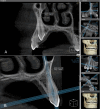Three-dimensional assessment of the skeletal characteristics accompanying unilateral maxillary canine impaction: a retrospective cone-beam computed tomography study
- PMID: 39427130
- PMCID: PMC11489996
- DOI: 10.1186/s12903-024-04974-4
Three-dimensional assessment of the skeletal characteristics accompanying unilateral maxillary canine impaction: a retrospective cone-beam computed tomography study
Abstract
Background: Environmental and genetic factors associated with canine impaction have been extensively researched, whereas the bone characteristics in the impaction area have not been thoroughly studied. Accordingly, the objective of this investigation was to provide a skeletal assessment in terms of bone density, bone microstructure, bone volume, and palatal volume in subjects with unilaterally impacted maxillary canines.
Methods: A retrospective design has been employed to address the aim of this study, where the initial pre-treatment cone-beam computed tomography (CBCT) scans of 30 patients with unilateral maxillary canine impaction were assessed. The obtained patients' data were equally divided according to the location of the impaction into 2 groups, one with buccally impacted canines, and another with palatal impactions, with the contra-lateral sides in both groups serving as the controls. Skeletal measurements such as bone density (BD), bone microstructure in terms of fractal dimension (FD), maxillary bone volume (MBV), and palatal volume (PV) were evaluated from the acquired CBCTs in both groups and compared to the controls.
Results: With buccal impactions, significantly greater BD and FD have been reported (p < 0.001), whereas non-significant differences were found regarding the PV when compared with controls (p = 0.56). MBV was significantly greater on the non-impaction side in comparison with buccal impaction sides (p < 0.001). For palatal impactions: BD, FD, and MBV were significantly greater on the impaction sides (p < 0.001), and conversely with PV which has been reported to be significantly greater on the non-impaction sides (p < 0.001).
Conclusions: As per the obtained results, buccally impacted canines are associated with greater BD and FD, and less MBV, whereas palatally impacted canines are accompanied with greater BD, FD, and MBV, in addition to less PV, when both conditions are compared with the non-impaction sides.
Keywords: Bone density; Bone microstructure; Bone volume; Cone-beam computed tomography; Fractal dimension; Palatal volume; Unilateral impaction.
© 2024. The Author(s).
Conflict of interest statement
The authors declare no competing interests.
Figures





References
-
- Grover PS, Lorton L. The incidence of unerupted permanent teeth and related clinical cases. Oral Surg Oral Med Oral Pathol. 1985;59:420–5. - PubMed
-
- Lai CS, Bornstein MM, Mock L, Heuberger BM, Dietrich T, Katsaros C. Impacted maxillary canines and root resorptions of neighbouring teeth: a radiographic analysis using cone-beam computed tomography. Eur J Orthod. 2013;35:529–38. - PubMed
MeSH terms
LinkOut - more resources
Full Text Sources
Medical
Research Materials

